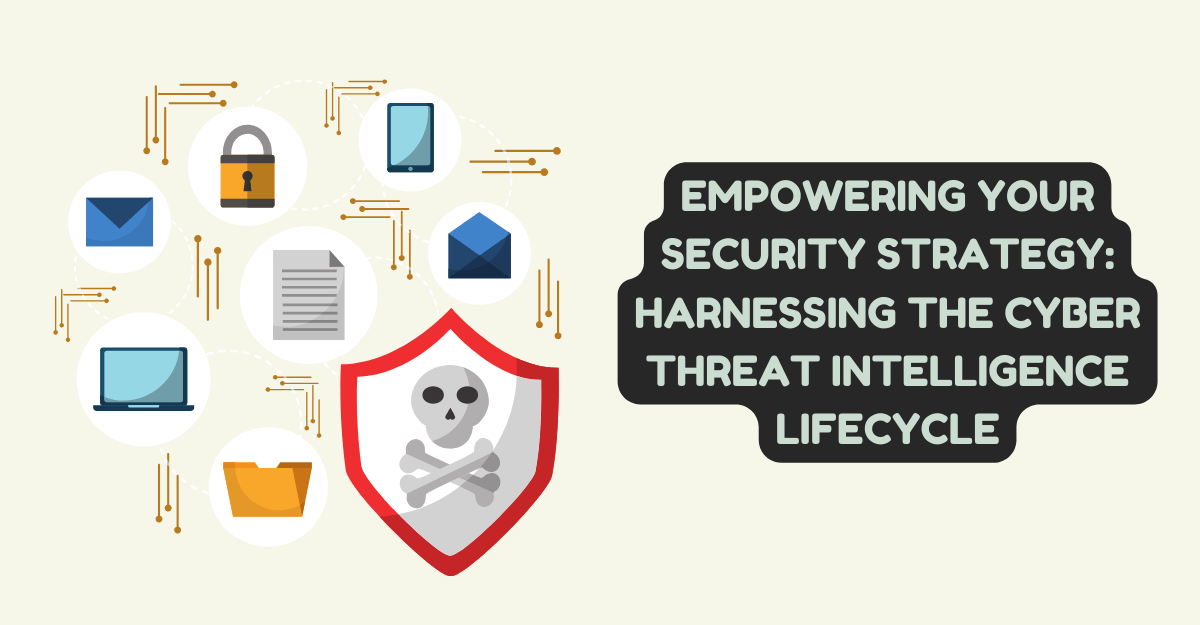
Empowering Your Security Strategy: Harnessing the Cyber Threat Intelligence Lifecycle
In today’s digital landscape, organizations face a myriad of cyber threats that constantly evolve in sophistication and complexity. From data breaches to ransomware attacks, the cyber threat landscape is more dynamic and challenging than ever before. In response, organizations must adopt proactive measures to defend against these threats effectively. One such approach is leveraging the Cyber Threat Intelligence (CTI) lifecycle to empower their security strategies.
Understanding the Cyber Threat Intelligence Lifecycle
The Cyber Threat Intelligence Lifecycle is a systematic approach to collecting, analyzing, and applying intelligence to enhance cybersecurity defenses. It consists of several interconnected stages, each serving a crucial function in the overall process. Let’s explore these stages in detail:
Planning and Direction
At the outset of the CTI lifecycle, organizations must establish clear objectives and goals for their intelligence program. This involves identifying key assets, determining threat priorities, and allocating resources effectively. Planning and direction lay the foundation for a successful CTI program by aligning it with the organization’s overall security strategy and business objectives.
Collection
Once the objectives are defined, the next step is collecting relevant data and information from various sources. These sources may include open-source intelligence, threat feeds, dark web forums, and internal sources such as network logs and incident reports. The goal of the collection phase is to gather comprehensive data on potential threats and adversaries.
Processing and Analysis
In this stage, collected data is processed, analyzed, and enriched to extract meaningful insights. Analysts employ various techniques such as data normalization, correlation, and contextualization to identify patterns, trends, and indicators of compromise (IOCs). The analysis phase transforms raw data into actionable intelligence, providing valuable insights into the tactics, techniques, and procedures (TTPs) employed by threat actors.
Production
Once the analysis is complete, the intelligence is packaged into actionable reports tailored to different stakeholders within the organization. These reports may include strategic intelligence for executives, operational intelligence for security teams, and tactical intelligence for incident responders. The production phase ensures that intelligence is disseminated effectively to support decision-making and response efforts.
Dissemination and Sharing
Effective sharing of intelligence is essential for maximizing its impact and value. During this stage, intelligence is shared internally across departments and externally with trusted partners, industry peers, and relevant government agencies. Collaboration and information sharing enhance collective defense efforts and enable organizations to stay ahead of emerging threats.
Consumption and Feedback
The final stage of the CTI lifecycle involves consuming intelligence to inform security decisions and practices. Feedback mechanisms are established to evaluate the effectiveness of intelligence in mitigating threats and improving security posture. Continuous feedback loops enable organizations to refine their intelligence processes and adapt to evolving threats effectively.
Key Benefits of the Cyber Threat Intelligence Lifecycle
Implementing the Cyber Threat Intelligence Lifecycle offers several key benefits for organizations seeking to enhance their security posture:
Proactive Threat Detection
By systematically collecting, analyzing, and disseminating intelligence, organizations can proactively detect and mitigate threats before they escalate into full-blown attacks. Early detection enables timely response and reduces the potential impact of cyber incidents.
Informed Decision Making
Access to timely and relevant intelligence empowers decision-makers to make informed choices about resource allocation, risk management, and incident response. Intelligence-driven decision-making ensures that security investments are prioritized based on the most significant threats facing the organization.
Enhanced Incident Response
Intelligence-derived insights enable security teams to respond more effectively to cyber incidents by providing them with actionable information about the nature of the threat, its scope, and potential impact. This facilitates a more coordinated and efficient incident response process.
Improved Risk Management
By understanding the tactics and techniques employed by threat actors, organizations can better assess and mitigate their cybersecurity risks. Intelligence-driven risk management enables organizations to focus their resources on the most critical areas of vulnerability. Moreover, embracing the cyber threat intelligence lifecycle not only fortifies organizations against evolving threats but also fosters a proactive security posture, enabling them to anticipate and mitigate risks effectively.
Strengthened Collaboration
The CTI lifecycle promotes collaboration and information sharing both within organizations and across industry sectors. By sharing intelligence with trusted partners and peers, organizations can leverage collective expertise and resources to combat shared threats effectively.
Best Practices for Implementing the Cyber Threat Intelligence Lifecycle
To maximize the effectiveness of the CTI lifecycle, organizations should adhere to the following best practices:
Establish Clear Objectives
Define clear objectives and goals for your CTI program aligned with your organization’s overall security strategy and risk appetite.
Invest in Technology and Tools
Leverage advanced technologies and tools to automate and streamline the collection, analysis, and dissemination of intelligence. Invest in threat intelligence platforms (TIPs), automation tools, and machine learning capabilities to enhance efficiency and effectiveness.
Cultivate Analyst Expertise
Build a team of skilled analysts with expertise in cybersecurity, threat intelligence, and data analysis. Provide ongoing training and professional development to keep your analysts abreast of the latest threats and techniques.
Foster Collaboration
Promote a culture of collaboration and information sharing within your organization and with external partners. Establish formalized channels and processes for sharing intelligence and coordinating response efforts.
Embrace Continuous Improvement
Regularly evaluate and refine your CTI processes based on feedback and lessons learned from real-world incidents. Embrace a mindset of continuous improvement to stay ahead of evolving threats.
Conclusion
In an increasingly hostile cyber landscape, organizations must arm themselves with the tools and techniques necessary to defend against emerging threats effectively. The Cyber Threat Intelligence Lifecycle offers a systematic approach to collecting, analyzing, and applying intelligence to enhance cybersecurity defenses. By implementing best practices and leveraging intelligence-driven insights, organizations can empower their security strategies and stay one step ahead of cyber adversaries.





